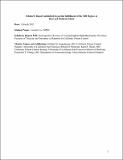Retrospective Review of Acetaminophen/Diphenhydramine Overdose: Features of Toxicity and Outcomes as Reported to California Poison Control

Access Status
Full text of the requested work is not available in DASH at this time ("restricted access"). For more information on restricted deposits, see our FAQ.Author
Lai, Lucinda
Metadata
Show full item recordCitation
Lai, Lucinda. 2017. Retrospective Review of Acetaminophen/Diphenhydramine Overdose: Features of Toxicity and Outcomes as Reported to California Poison Control. Doctoral dissertation, Harvard Medical School.Abstract
Purpose: Acetaminophen (APAP) combination products are commonly involved in overdose. We hypothesize that patients who ingest APAP/diphenhydramine combination products experience prolonged gastrointestinal absorption of APAP, such that the standard diagnostic nomogram and 21-hour treatment protocol would underestimate the true risk of hepatotoxicity.Methods: We retrospectively reviewed 213 cases of APAP/diphenhydramine and 149 cases of plain APAP overdose that had resulted in hepatotoxicity and were reported to the California Poison Control System from 1997 to 2013.
Results: No significant differences were observed between the APAP/diphenhydramine and plain APAP groups in terms of demographics or clinical presentation, except that the former group was more likely to have received activated charcoal (p = 0.0015). We identified cases of hepatotoxic APAP/diphenhydramine overdose that demonstrated prolonged APAP absorption that necessitated extended NAC therapy. This study did not find evidence, however, that this group of patients experienced worse clinical outcomes in terms of mortality or need for liver transplantation. Comparing cases of hepatotoxicity versus minor hepatic injury in the setting of APAP/diphenhydramine overdose, an APAP-aminotransferase multiplication product (APAP x AT) greater than the pre-specified cut-off point of 1500 mg ∙ IU/L2 had a sensitivity of 95% (95% confidence interval [CI]: 88% to 99%) for predicting hepatotoxicity, and an odds ratio of 5.7 (95% CI: 1.6. – 20.0). No cases of hepatotoxicity were observed among patients who had presented initially with undetectable APAP and normal transaminase levels.
Conclusions: These data provide evidence that APAP combination products pose unique risks to patients and modification of the NAC treatment protocol may be necessary to prevent significant hepatic injury and death.
Terms of Use
This article is made available under the terms and conditions applicable to Other Posted Material, as set forth at http://nrs.harvard.edu/urn-3:HUL.InstRepos:dash.current.terms-of-use#LAACitable link to this page
http://nrs.harvard.edu/urn-3:HUL.InstRepos:40621407
Collections
Contact administrator regarding this item (to report mistakes or request changes)

